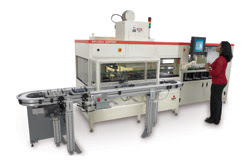Solar and solid-state-lighting industries provide job prospects for everyone from the engineer to the production worker.
Reducing greenhouse gas is a mandate of governments worldwide and, key to accomplishing that goal, is being smarter about energy generation and use. With jobs falling off in so many industries, the green way of doing business is opening up new opportunities.
The sunny side
The solar industry has continued to grow over the past few years. By the end of 2007, the cumulative global capacity was more than 9 GWp (gigawatts peak), compared with less than half that in 2004, according to the European Photovoltaic Industry Association (EPIA). In a report released by the EPIA and Greenpeace, it is estimated that, by 2030, photovoltaics technology could supply electricity to 3.7 million people globally.
With solar use on the rise, job growth is expected in many of the areas that serve the industry. In Europe, 75,000 jobs have been created in the photovoltaics industry. The European Photovoltaic Technology Platform estimates that another 200,000 jobs will be created by 2020.
In the US, the Department of Energy (DoE)’s Solar America Initiative is partnering with universities and national laboratories to develop and deliver photovoltaic and concentrated solar energy. These efforts are expected to create 30,000 new jobs by 2015, and 80,000 by 2030. The DoE’s Solar Energy Technologies Program launched its Market Transformation initiative last month, focusing on building the capacity of educational institutions to train solar installers and code officials to meet the anticipated demand.
Spire Corp. of Bedford, Mass., provides photovoltaic production equipment to manufacturers worldwide. Its revenue increased 90 percent between 2006 and 2007, and, according to Mark Willingham, vice president of sales and marketing, the boom is trickling down the supply chain.
Spire hires electrical, mechanical and optical engineers for the development of its production equipment and sun simulators and provides training for its customers – an area where those with a strong optics background are in demand. It has added 44 positions in the past year, a growth rate of nearly 25 percent.

A worker operates a cell sorter, which sets up test diagnostics, runs tests and sorts PV cells under simulated sunlight according to electrical performance. Photo courtesy of Spire Corp.
Willingham said Spire is not alone in this growing industry. “We do have competitors setting up shop, and they’re likely to hire people in all parts of the business.”
A new light show
Despite the best efforts to reduce energy use, electricity continues to be the fastest-growing form of energy use worldwide, with lighting accounting for 20 percent. Typical incandescent lighting is extremely energy-inefficient, converting only 10 percent of the energy it consumes into light, while compact fluorescents convert about 25 percent.
Solid-state lighting, on the other hand, could save bundles – or tons, depending on how you look at it. According to the DoE, when solid-state lighting (LEDs) reaches its projected efficiency, the US could save the equivalent of the output of about 30 large power plants – about 155 million tons in carbon emissions – or nearly 7 percent of the country’s electricity costs. In terms of jobs, LEDs and solar have many of the same technical underpinnings, including silicon, semiconductors, thin film and nanotechnology.
Global greening
According to a report from the Center on Globalization, Governance & Competitiveness at Duke University in Durham, N.C., titled “Manufacturing Climate Solutions: Carbon-Reducing Technologies and U.S. Jobs,” the market for LEDs is growing. In 2007, the global LED market was $4.6 billion, although the general lighting portion of that was only 7 percent. Mobile appliances accounted for 44 percent; displays, 17 percent; and automotive, 15 percent. The global lighting market is estimated at $40 billion to $100 billion annually, so, clearly, there is huge potential for LED lighting, which is forecast to reach $1.6 billion by 2012.
In terms of job growth, Cree Inc. of Raleigh, N.C., is one company that has remained in the forefront of the LED market. The company quadrupled its work force to nearly 3200 workers in five years. Its revenue grew from $228 million in 2003 to $493 million in 2008. Other major players in the LED lighting market are Philips Lighting Inc. of Guildford, UK, Osram GmbH of Munich, Germany, and the US-based General Electric Co. under its subsidiary Lumination LLC.